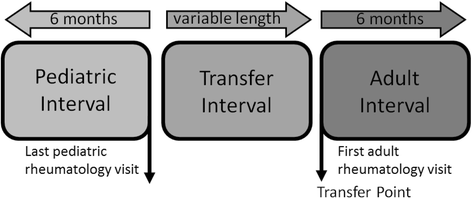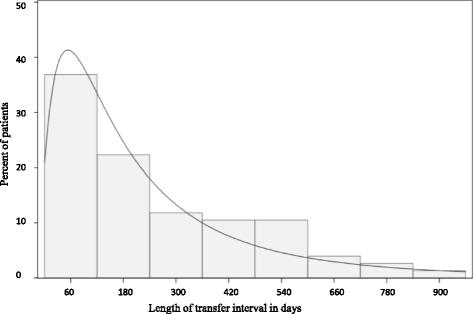Analysis of health care claims during the peri-transfer stage of transition from pediatric to adult care among juvenile idiopathic arthritis patients
- PMID: 27596158
- PMCID: PMC5012002
- DOI: 10.1186/s12969-016-0107-3
Analysis of health care claims during the peri-transfer stage of transition from pediatric to adult care among juvenile idiopathic arthritis patients
Abstract
Background: To investigate the utilization of health care services before and after transfer from pediatric to adult rheumatology care in clinical practice.
Methods: Using US commercial claims data from January 2005 through August 2012, we identified individuals with a JIA diagnosis code from a pediatric rheumatologist followed by any diagnosis code from an adult rheumatologist. Individuals had 6 months observable time before the last pediatric visit and 6 months after the first adult visit. Medication, emergency room, physical therapy use, and diagnosis codes were compared between the pediatric and adult interval using McNemar's test. The proportion of days covered (PDC) of TNFi for the time between last pediatric and first adult visit was calculated.
Results: We identified 58 individuals with JIA who transferred from pediatric to adult rheumatology care after the age of 14. The median age at the last pediatric rheumatology visit was 18.1 years old and the median transfer interval was 195 days. 29 % of patients received NSAIDs in the adult interval compared to 43 % in the pediatric interval (p = 0.06). In the pediatric interval, 71 % received a JRA and 0 % received an RA physician diagnosis code compared to 28 and 45 %, respectively, in the adult interval. The median PDC for patients receiving a TNFi was 0.75 during the transfer interval.
Conclusion: Individuals with JIA who transferred to adult care were more likely receive a diagnosis of RA instead of JRA and were less likely to receive NSAIDs, but had no significant immediate changes to other medication use.
Keywords: Administrative claims; Juvenile idiopathic arthritis (JIA); Transition to adult care.
Figures
References
MeSH terms
Substances
Grants and funding
LinkOut - more resources
Full Text Sources
Other Literature Sources
Medical



